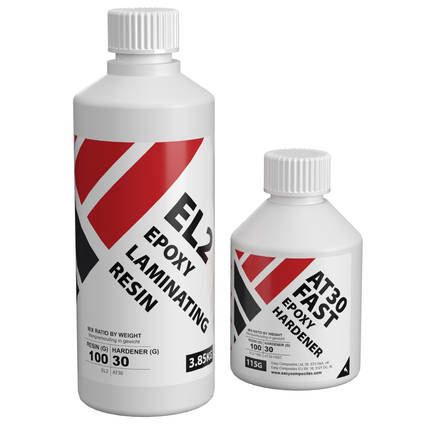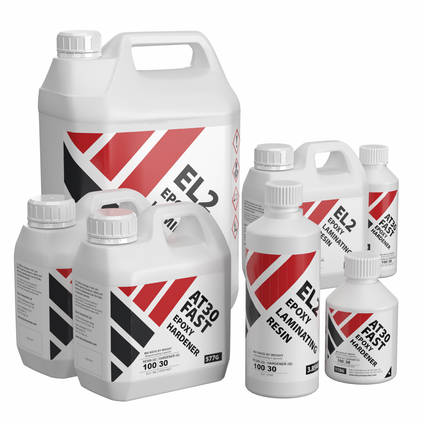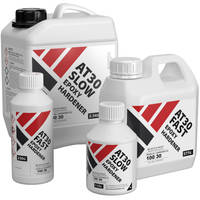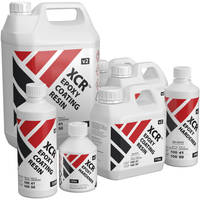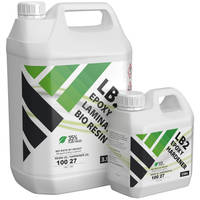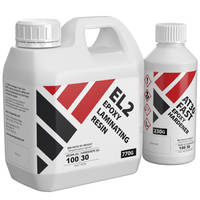Need any help or advice?+44 (0)1782 454499
Downloads (3)
This is a chemical product. Before storage or use you must download and read the accompanying safety and technical datasheets.
| Safety Datasheet (SDS) - EN | ||
| Safety Datasheet (SDS) - NL | ||
| Technical Datasheet (TDS) |
Specification
Cured Mechanical Properties
| Max Service Temp | 83 | °C |
|---|---|---|
| Compressive Strength | 88 - 98 | MPa |
| Hardness | 87 (Hard) | Shore D |
| Flexibility | Hard / Rigid | |
| Tensile Strength | 67 - 75 | MPa |
| Flexural Strength | 120 - 130 | MPa |
| Flexural Modulus | 3.6 - 4.0 | GPa |
| Elongation at Break | 6.0 - 8.0 | % |
| Tg Onset (DMA) | 70 - 76 | °C |
Product Data
| Colour | Clear | |
|---|---|---|
| Chemistry / Material | Epoxy | |
| Viscosity | 1200 | mPa.s |
| UV Resistance | Very Good | |
| Brand | Easy Composites | |
| Shelf Life | 12 | Months |
Pot Life and Cure Times
| Pot Life (Typical) | 14 | mins |
|---|---|---|
| Initial Cure Time | 5 | Hrs |
General Properties
| Gross Weight | 0.576 | kg |
|---|
Shipping Information
Restrictions
This product is classed as dangerous goods for transport.
It can be shipped to all mainland EU countries, Ireland, Balearic Islands, Corsica, Sicily and Sardinia.
Unfortunately, for the time being we are unable to ship dangerous goods to Cyprus, Malta, the Canary Islands, Ceuta, Melilla, Jan Mayan and Svalbard.
For a full information regarding the shipment of dangerous goods, see our delivery information page.
Package Size
There are no package size restrictions or surcharges for this product.
Delivery Cost
To find the delivery cost of this item to your address, add it to your basket and then use the instant shipping calculator on the basket page.
EL2 Epoxy Laminating Resin
- EP-L2-F-05
Hazardous
- 5/5 Average rating
EL2 is a high performance epoxy laminating resin suitable for hand-layup of reinforcements such as carbon fibre, aramid and glass fibre. Its combination of mechanical performance, fast wet-out, easy handling and great value make EL2 a hugely popular choice in motorsport, boat-building, model-making and general composites.
Sold as a kit (resin and hardener). Available to buy online with a choice of FAST or SLOW hardener in 500g, 1kg and 5kg kits.
PRODUCT VERSIONS
Kit Size
Speed
AVAILABILITY:More than 10 availablefor immediate shipping
We won’t be beaten on price!
If you believe you’re buying an equivalent product cheaper elsewhere, contact us to discuss your requirements.
High performance general purpose epoxy laminating resin for use in wet-lay or vacuum bagging carbon fibre, Kevlar or glass fibre lamination.
This low viscosity epoxy exhibits excellent wetting characteristics especially when used as an epoxy resin for carbon fibre and aramid fibre (Kevlar) reinforcement making air-bubbles in the laminate less likely than with some alternative epoxy systems.
The resin also exhibits excellent cured mechanical properies far in excess of many more traditional epoxy resin brands (as can be seen from the technical data sheets). Improved mechanical properties mean stronger, lighter, higher performance parts.
In all sizes the epoxy is sold as a pack which means it includes the resin and the correct amount of hardener.
FAST and SLOW Hardeners
EL2 is available with a choice of two hardener speeds; 'FAST' which has a pot-life of 12-17mins and is de-mouldable in around 8hrs and 'SLOW' which provides a pot-life of 95-115mins and is de-mouldable in around 30hrs.
In addition to the options of FAST or SLOW hardener, we have recently added the option to split the hardeners and have half FAST and half SLOW on the 1kg and 5kg pack sizes. If selected, the hardeners will therefore be supplied as one pack of FAST and one pack of SLOW at the correct proportion to the resin kit.
Unfortunately we are unable to offer mixed hardener speeds on the 500g kit sizes.
FAST and SLOW hardeners can be blended to achieve pot-life and demould times anywhere between those stated in the specifications. However, you must still maintain the correct overall ratio of resin to hardener to ensure a proper cure.
Typical Uses
Use as a general purpose laminating layup epoxy resin for wet-laying or vacuum bagging composites such as glass fibre, carbon fibre and aramid fibre (Kevlar).
When cured the epoxy exhibits outstanding mechanical characteristics making it will suited to the lamination of structural parts. The resin also exhibits excellent clarity making it also suitable for use when laminating unpainted (or pigmented) carbon fibre composites.
We also have a bio version of our laminating resin which replaces the fossil fuel based content with a bio derived alternative. You can find it here: LB2 Epoxy Laminating Bio Resin
Further Information
Laminating Kit Top-Ups
This is the resin that is used in our Carbon Fibre Laminating Starter Kit. If you're wanting to make your own larger version of one of our kits then this is the resin you need.
Compatibility Information - Dos and Don'ts
Although by no means an exhaustive list, the mould materials, pigments and additives listed below have all been tested and are known to work well with EL2.
Compatible Moulds
- Uni-Mould Mould System
- Epoxy Tooling Gelcoat
- Epoxy gelcoat based moulds
- Polypropylene and polyethylene sheet
- Aluminium
- Toughened Glass (eg. flat sheet manufacture)
Compatible Pigments
- Epoxy Colour Pigment * (for vivid opaque colours)
- Translucent Tinting Pigment * (for less vivid opaque colours)
Compatible Fillers
- All dry filler powders
* With bold coloured laminates such as carbon fibre, the underlying colour of the fabric may still show through the pigmented resin, especially with thinner layers of resin over the underlying laminate.
Key Processing Information
- Ease of Use: Suitable for professional and hobby use (follow SDS advice).
- Odour: EL2 is almost odourless.
- Safety Precautions: Wear gloves and goggles and work in a well ventilated area. Always read the SDS before use.
- Ambient Conditions: Can be used from 15 to 30°C although pot-life and cure time will be affected significantly. Recommended working at an ambient of 20-25°C.
- Degassing: Not necessary in most cases. Simply mix and use.
- Mix Ratio: Mix 'Resin' and 'AT30 Hardener' 100:30 by weight. Use digital scales.
- Mixing: Mix thoroughly by hand for at around 2 minutes.
- Pot-Life: FAST Hardener 12-17mins. SLOW Hardener 95-115mins. Be sure to use your resin before this time.
- Exotherm (Over-Heating): Resin will heat-up whilst it cures. Mix in small batches and use expediently. Mixed resin in a pot will quickly overheat (exotherm) and can smoke/ignite. Never leave mixed resin unattended.
- Cure Time/Demould: At 25°C you can expect a typical cure time to be 4-6hrs for the FAST & 20-30hrs for SLOW AT30 hardeners.
- Pigments and Fillers: A wide range of pigments and fillers can be added to change the properties and appearance of Resin.
High performance general purpose epoxy laminating resin for use in wet-lay or vacuum bagging carbon fibre, Kevlar or glass fibre lamination.
This low viscosity epoxy exhibits excellent wetting characteristics especially when used as an epoxy resin for carbon fibre and aramid fibre (Kevlar) reinforcement making air-bubbles in the laminate less likely than with some alternative epoxy systems.
The resin also exhibits excellent cured mechanical properies far in excess of many more traditional epoxy resin brands (as can be seen from the technical data sheets). Improved mechanical properties mean stronger, lighter, higher performance parts.
In all sizes the epoxy is sold as a pack which means it includes the resin and the correct amount of hardener.
FAST and SLOW Hardeners
EL2 is available with a choice of two hardener speeds; 'FAST' which has a pot-life of 12-17mins and is de-mouldable in around 8hrs and 'SLOW' which provides a pot-life of 95-115mins and is de-mouldable in around 30hrs.
In addition to the options of FAST or SLOW hardener, we have recently added the option to split the hardeners and have half FAST and half SLOW on the 1kg and 5kg pack sizes. If selected, the hardeners will therefore be supplied as one pack of FAST and one pack of SLOW at the correct proportion to the resin kit.
Unfortunately we are unable to offer mixed hardener speeds on the 500g kit sizes.
FAST and SLOW hardeners can be blended to achieve pot-life and demould times anywhere between those stated in the specifications. However, you must still maintain the correct overall ratio of resin to hardener to ensure a proper cure.
Typical Uses
Use as a general purpose laminating layup epoxy resin for wet-laying or vacuum bagging composites such as glass fibre, carbon fibre and aramid fibre (Kevlar).
When cured the epoxy exhibits outstanding mechanical characteristics making it will suited to the lamination of structural parts. The resin also exhibits excellent clarity making it also suitable for use when laminating unpainted (or pigmented) carbon fibre composites.
We also have a bio version of our laminating resin which replaces the fossil fuel based content with a bio derived alternative. You can find it here: LB2 Epoxy Laminating Bio Resin
Further Information
Laminating Kit Top-Ups
This is the resin that is used in our Carbon Fibre Laminating Starter Kit. If you're wanting to make your own larger version of one of our kits then this is the resin you need.
Compatibility Information - Dos and Don'ts
Although by no means an exhaustive list, the mould materials, pigments and additives listed below have all been tested and are known to work well with EL2.
Compatible Moulds
- Uni-Mould Mould System
- Epoxy Tooling Gelcoat
- Epoxy gelcoat based moulds
- Polypropylene and polyethylene sheet
- Aluminium
- Toughened Glass (eg. flat sheet manufacture)
Compatible Pigments
- Epoxy Colour Pigment * (for vivid opaque colours)
- Translucent Tinting Pigment * (for less vivid opaque colours)
Compatible Fillers
- All dry filler powders
* With bold coloured laminates such as carbon fibre, the underlying colour of the fabric may still show through the pigmented resin, especially with thinner layers of resin over the underlying laminate.
Key Processing Information
- Ease of Use: Suitable for professional and hobby use (follow SDS advice).
- Odour: EL2 is almost odourless.
- Safety Precautions: Wear gloves and goggles and work in a well ventilated area. Always read the SDS before use.
- Ambient Conditions: Can be used from 15 to 30°C although pot-life and cure time will be affected significantly. Recommended working at an ambient of 20-25°C.
- Degassing: Not necessary in most cases. Simply mix and use.
- Mix Ratio: Mix 'Resin' and 'AT30 Hardener' 100:30 by weight. Use digital scales.
- Mixing: Mix thoroughly by hand for at around 2 minutes.
- Pot-Life: FAST Hardener 12-17mins. SLOW Hardener 95-115mins. Be sure to use your resin before this time.
- Exotherm (Over-Heating): Resin will heat-up whilst it cures. Mix in small batches and use expediently. Mixed resin in a pot will quickly overheat (exotherm) and can smoke/ignite. Never leave mixed resin unattended.
- Cure Time/Demould: At 25°C you can expect a typical cure time to be 4-6hrs for the FAST & 20-30hrs for SLOW AT30 hardeners.
- Pigments and Fillers: A wide range of pigments and fillers can be added to change the properties and appearance of Resin.
Specification
Cured Mechanical Properties
| Max Service Temp | 83 | °C |
|---|---|---|
| Compressive Strength | 88 - 98 | MPa |
| Hardness | 87 (Hard) | Shore D |
| Flexibility | Hard / Rigid | |
| Tensile Strength | 67 - 75 | MPa |
| Flexural Strength | 120 - 130 | MPa |
| Flexural Modulus | 3.6 - 4.0 | GPa |
| Elongation at Break | 6.0 - 8.0 | % |
| Tg Onset (DMA) | 70 - 76 | °C |
Product Data
| Colour | Clear | |
|---|---|---|
| Chemistry / Material | Epoxy | |
| Viscosity | 1200 | mPa.s |
| UV Resistance | Very Good | |
| Brand | Easy Composites | |
| Shelf Life | 12 | Months |
Pot Life and Cure Times
| Pot Life (Typical) | 14 | mins |
|---|---|---|
| Initial Cure Time | 5 | Hrs |
General Properties
| Gross Weight | 0.576 | kg |
|---|
Uncured resins are classed as dangerous goods and would need to be disposed of correctly. For domestic users, usually your local council recycling centre will have a disposal service for such chemicals or containers.
Because cured resins are inert and safe for disposal it's often easiest to mix un-needed or out-of-date resin and hardener together to cure them. Once cured they can be disposed of with general waste.
Unlike other resin systems such as polyester or vinylester, it's very important to get the mix ratios accurate with epoxies. If you get the mix ratio wrong by a small amount (let's say a couple of grams on a small mix) then the resin will still cure but the mechanical properties won't be quite as good as they would have been if the mix ratio had been exactly right. However, if you were to be out by anything more than a few grams then you might find that the resin would not be properly hard when cured and/or may have a tackiness to the finish. This would result in a much weaker repair and needs to be avoided by careful measurements.
No, we wouldn’t suggest Epoxy Resins for lining a fuel tank. In general, epoxies have good resistance to petrol and many of the chemicals and additives found within pump fuel however the ethanol in fuel is known to cause problems over time and so specialist tank lining resins (often novalac vinylester based) should be used instead. One such product is GTS 1750 which is sold by Caswell Europe.
No, this epoxy in common with other epoxies does not attack expanded polystyrene
We have not specifically saught FDA (or similar) approval for this resin system so if you were to make these plates commercially then you would either need to make a plate using this resin system and then have it tested and approved safe for food use or use a different resin system that has specifically been approved for food use. Mixed and cured fully and properly the resulting plastic should be stable and non-toxic but testing would be required to prove this. Regarding being dishwasher safe; a dishwasher is a very harsh environment (abrasive, high temperatures, caustic) and so I think it would be quite hard on any resin system. By all means conduct your own tests but I would strongly recommend that a carbon fibre plate was not marketed as 'dishwasher safe'.
Above the HDT of a resin system it will soften slightly and its mechanical properties will start to fall away however a thermosetting plastic (like epoxy) is NOT a thermoformable plastic so it will not start to flow again such that you could melt it out of your part. It's more likely to become slightly soft and then possible more brittle again before eventually starting to burn if you too the temperature high enough. It sounds to me like you need a thermoformable plastic (aka a thermoplastic) with a relatively low melting point. I'd suggest something like PCL.
An elevated temperature post-cure is not required for parts made with epoxy resin however, post curing parts will improve the mechanical properties of the resin (and therefore the part) and so if you have the means to do it then it's certainly recommended. One major advantage to post-curing epoxy is that you will raise the HDT (heat distortion temperature) of the part meaning that it's less likely to soften or distort in higher temperatures. This can be particularly important for parts like a vehicle panel (i.e. hood/bonnet) which could get very hot in the sun. Without a post-cure there is a good chance that the part would effectively post-cure itself 'in situe' when it's in direct sunlight which can cause the resin to soften, sink and then re-harden. When this happens to a fitted part it's likely to distort the surface finish. A part that had been post-cured prior to installation would not have this problem.
Epoxy resins have very little odour and so it's quite viable to use them indoors (i.e. in your house) without upsetting anyone. The resin is almost completely odourless and the hardener has an amonia smell which doesn't really carry or linger.
In this respect epoxies are very different to polyester and vinylester resin which has a very strong smell and cannot realistically be used indoors. As always, you should still follow safety precautions and ensure adequate ventilation of your work area.
Although generally cured epoxies are non-hazardous, none of the products we have are certified food safe and thus we cannot recommend their use with food products.
We recommend Acetone. The brushes must be cleaned before the resin has cured. If you can’t get hold of acetone it’s also possible to use methylated spirits or neat alcohol.
In really simple terms you can think of 1kg of the Epoxy Resin as being 1L. If you want to be really exact (for example if you want to mix the resin and the hardener by volume and not by weight (which we don't recommend because it's unnecessarily complicated) then the relative density of the resin and the hardener, and the mixed product, can be found on the technical datasheet.
We can send any quantity of resin to Portugal. We would use a TNT Road service. To find the shipping cost for any item, simply add it to your basket and then click the 'Estimate Shipping' button on the basket page. The price will then be shown once you chose your shipping country (Portugal).
The B stage of the cure is when the resin has cured enough to be firm but still tacky. When touching with a gloved finger, the resin should feel tacky but not leave any residue on the glove.
Epoxy is sensitive to low temperatures so we would not attempt to try and cure the resin at very low temperatures such as below 15 °:C. At those temperatures, the cure time will be lengthened considerably.
One of the most significant problems caused by low temperatures (much below 20°C) is that the resin will be considerably thicker which affects its ability to self-degas after pouring.
Also, curing epoxies are hydroscopic so the low temperature environment may well leave the resin vulnerable to absorbing moisture, especially if the environment is relatively damp or high in humidity as can be found in some outdoor workshops or home garages.
As a result, for best results we always recommend working in an environment that is 20°C or above.
Yes, but it's highly recommended to use specialist 'powder bound' chopped strand matt. This is because conventional chopped strand matt is 'emulsion bound' which relies on styrene and solvents in the resin to break the binding down. Epoxy does not have these solvents. As a result, specialist 'powder bound' chopped strand matt is needed as the powder binding is broken down by the liquid itself.
Most cured epoxy resins have self-extinguishing properties however none of our epoxies have formal 'fire rating' data because they're not designed as intumescent or fire retardant resins. The reinforcement you use will also have an impact on the fire retardancy of the finished product.
If you're specifically setting out to make fire-retardant parts I would suggest using a specialist intumescent resin - however, bear in mind that generally these resins will contain inert fillers which compromise their mechanical performance to some extent.
As with many post-cure cycles for resins, the post-cure cycle for our EL2 and IN2 Epoxy Resins is not too sensitive and a range of different post-cure cycles will produce good results, specifically improved mechanical performance and elevated HDT/operating temperature. Post-curing parts that will be used at or exposed to elevated operating temperatures (such as vehicle bonnets/hoods in direct sunlight, engine-bay parts, car interior parts etc.) is strongly recommended to prevent distortion of the parts when they are put into service and experience these higher temperatures.
Where possible, parts should be post-cured still inside the mould to reduce distortion and improve surface finish (i.e. reduce 'print-through'). When post-curing parts in the mould, it is important to post-cure them without demoulding at all (i.e. don’t demould and then put them back into the mould) otherwise you can get some strange patterns on the surface where some areas are post cured in direct contact with the mould surface and others are not.
A simple and very effective post-cure cycle with the IN2 Infusion Resin (or EL2 Epoxy Laminating Resin) is as follows:
CYCLE #1 SUITABLE FOR MOST SITUATIONS
- 24hrs at room temperature
- 6hrs at 60°C
If you’re encountering any surface finish issues (faint print-through) then you can experiment with a slower 'ramp rate' which sometimes improves things:
CYCLE #2 SUGGESTED FOR SUBTLE IMPROVEMENTS TO SURFACE FINISH
- 24hrs at room temperature
- 2hrs at 40°C
- 2hrs at 50°C
- 5hrs at 60°C
If you need to push the HDT of the finished part higher then you could increase post-cure up to a maximum of 80°C as follows:
CYCLE #3 SUGGESTED FOR HIGHEST POSSIBLE HDT/OPERATING TEMPERATURE
- 24hrs at room temperature
- 2hrs at 40°C
- 2hrs at 50°C
- 2hrs at 60°C
- 2hrs at 70°C
- 4hrs at 80°C
These are all just suggestions. Most situations just call for option #1; 6hrs at 60°C. Many customers also find that they can dispense with the 24hrs cure at ambient and simply load newly infused parts into the oven to begin the cure however this is something that you would need to experiment with yourself. A cure at ambient temperature before post-cure is generally favoured with most resin systems.
Yes, the EL2 laminating resin can certainly be used with composites shrink tape, in fact it's a general purpose laminating epoxy and so open 'hand-layup', vacuum bagging, shrink wrapping and many other processes are all suitable. It's actually EL2 laminating epoxy that we include in our Fishing Pole Repair Kit and in this process composites shrink tape is wrapped around the repair which is made using the EL2 resin.
EL2 is not suited to forged carbon due to its viscosity. Also it is limited to 80C. The EL160 will go to 160C with an oven post cure which may be more suitable.
Hello! I’m making a single structural part in carbon fiber. The part has no draft angles so it would traditionally need a two or three part mould. To simplify the process I was thinking about hand-laminating multiple layers of 2x2 twill (possibly the stabilised version) on the outside of a high density extruded polystyrene foam mould, then using acetone to dissolve the foam after the resin has cured. Would the EL2 be suitable for this kind of a process?
Yes, you could certainly use the EL2 Laminating Epoxy for this application. Once fully cured EL2 has excellent chemical resistance so wouldn't be affected by the acetone. You do need to make sure it is fully cured though before you expose it to acetone so be patient and don't try to dissolve that core too soon.
A really good tip for this process is to slice the polystyrene core in two (lengthways, in slightly opposite wedge shapes) and then wrap some release film (like R210 Release Film) around it, before you then do the layup around the outside, directly onto the release film. Once the resin has cured, you can usually push the two 'wedge' halves in opposite directions and then just remove them whole, without any messy dissolving. If you can't, it's still easier to extract the foam if there's a release film between it and the cured composite. And finally, if you did need to dissolve it out, the release film keeps the acetone away from your laminate; although not necessary, this can't be a bad thing.
and want to know which resin will perform better in cold conditions still allowing flex without fractures during repetitive use?
Our EL2 is a good performing resin in very cold conditions and still maintains the necessary flex for use on ski's and snowboards. Unlike some other resins, it does not become brittle.
We would not recommend attempting to thin the EL2 resin as it is likely to be damaged in the process. Our IN2 Epoxy Infusion Resin already has a considerably lower viscosity than the EL2, so would be a better resin to use in this case.
Generally, correctly used and fully cured epoxies are therefore would not have any reaction (or cause any contamination) of the water. However, we would recommend consulting an aquatic specialist to be sure or use a specifically tested 'aquarium safe' resin system.
Yes our EL2 is quite commonly used in this fashion for instruments as well as sporting equipment. As long as the wood laminate strips have a good key, the resin will bond very well.
Yes, our EL2 laminating resin is commonly used on model aircraft to laminate light weight fibreglass skins with and is perfectly suited to the task.
No, we would not recommend EL2 as a pourable coating resin. The resin itself is quite clear when cured, even when quite thick but this resin is not designed as a pourable clear coating resin such as you're describing, mainly because if you pour EL2 and leave it to settle, when it cures the surface won't be quite as flat and glossy as you would want for picture coating. Instead, we would suggest using our ArtResin Clear Epoxy Coating Resin.
If you're looking to add a beautifully clear, glossy, UV stable coating to your artwork, photos or other creative projects then world-renowned ArtResin offers unsurpassed performance coupled with incredible ease-of-use for perfect results, every time. If you do experiment with coating over pictures then it's important to seal certain types of picture first using PVA glue before applying the resin, otherwise the resin can 'wet them out' spoiling the appearance.
Yes, certainly. We would recommend our EL2 for making repairs to any damaged composite boat. Being an epoxy it will bond well to the existing hull, whether that's been made using epoxy, polyester or vinylester resin so you have no concerns there. Also, being a high performance resin you'll get a really strong repair.
The EL2 resin would be suitable for glass, carbon or carbon/kevlar laminates.
You could use this as a rod-finish but our Epoxy Coating Resin would make a better choice. It cures with a cleaner, glossier finish than other epoxies.
Our EL2 is actually quite a clear epoxy system although it's not really designed as a clear casting resin. My suggestion would be to use our Waterclear Polyurethane Casting Resin to make an indicator lamp. You could add a few drops of our Translucent Resin Tinting Pigments to get the perfect orange or red tint if you needed it. The Waterclear PU is designed for casting and is also totally UV stable.
EL2 is from the new generation of UV resistant epoxies but, in common with all epoxies, it is not 100% UV stable. To make an epoxy completely UV stable you would need to finish it with something like a 2k lacquer/clear coat. For an application like a kite-board however where the part won't be subjected to prolonged exposure (in the same way that something like a car bonnet would be) then I would not expect any problems at all, even without a clearcoat/lacquer.
We state the shelf-life of all our epoxy resins as 12 months from the date of purchase. In reality, the shelf-life of the resin is actually a lot longer than that of the hardener; the EL2 resin for example is perfectly useable after up to 3 years from manufacture whereas the hardener will start to deteriorate noticeably much after the 12 months.
Yes our EL2 Epoxy Laminating Resin has been successfully used on model aircraft wings and fuselages either as a coating or when laminating the skin itself. The resin’s good mechanical properties and good wetting out characteristics are ideally suited for such applications.
Yes, and it works well for this purpose. EL2 will wet-out the fibreglass very well and cures virtually clear. Ideally, we would then recommend rubbing back the surface and finishing it with a lacquer or varnish for a really glossy finish with good UV stability.
Yes, EL2 bonds well to Polyester resin (i.e. typical fibreglass) given the appropriate preparation. In most cases, thoroughly cleaning the surface and keying it with a coarse abrasive paper will provide a suitable surface for the epoxy to achieve a good bond.
EL2 is designed as a laminating resin and not a casting resin so anything over 1mm thick in one pour and you could run into problems with the resin exotherming (getting too hot during the cure). Using the SLOW hardener would help a lot and, although not designed as a casting resin, a 5mm thick cast should be possible without exotherm problems.If you are after a water clear casting resin then we suggest you look at our Water Clear Polyurethane Casting Resin.
EL2 is intended as a laminating resin which means it would normally be being used to wet out a woven fabric (carbon, glass etc.) and when used like this it can be used to laminate up vertical surfaces without excessive draining. If you tried to use EL2 more like a coating resin or a gelcoat then it would tend to drain off vertical surfaces unless you made it more thixotropic by mixing in a small amount ofFumed Silica Thixotropic Powder.
Yes, our EL2 works very well for laminating natural fibres such as the fibres found in our Biotex Dry Natural fibre range.
Our EL2 is suitable for both wet lay projects and vacuum bagged projects.
EL2 can be overcoated when dry with no issues as long as the surface is properly prepared. A good key with 120 Grit sandpaper and thorough clean should ensure the surface is ready to overcoat.
Yes certainly. By coating a layer of resin over the part, it will likely fill and smooth the overall surface and also seal the MDF so it's no longer permeable/porous. Most modern paints will adhere to epoxy resin once it has been keyed with sandpaper and thoroughly cleaned and de-greased.
Yes EL2 will bond to and cure when used over/with Epoxy Mould Making Putty. This can be quite useful if you want to back up your putty based mould with additional reinforcement or help seal the surface for a tidier finish or stronger mould.
ASK YOUR OWN QUESTION
Customer Product Reviews for EL2 Epoxy Laminating Resin
Very pleased with this resin, the slow setting time makes it easy to fiberglass awkward shapes. Also it bonds well to most materials.
Best epoxy on the market, use it for work as a joiner/maker as well as boat work, Admittedly it doesn't have a picture of a boat on the tin so is actually reasonably priced. This product is head and shoulders better than the usual marine stuff and at almost half the price, what are you waiting for. www.rogerball.co.uk www.agentlemansyacht.com
SUBMIT YOUR OWN PRODUCT REVIEW
We publish all reviews for verified purchases. Submit your own review and help other customers with their choices.SUBMIT YOUR OWN PRODUCT REVIEW
We publish all reviews for verified purchases. Submit your own review and help other customers with their choices.Shipping Information
Restrictions
This product is classed as dangerous goods for transport.
It can be shipped to all mainland EU countries, Ireland, Balearic Islands, Corsica, Sicily and Sardinia.
Unfortunately, for the time being we are unable to ship dangerous goods to Cyprus, Malta, the Canary Islands, Ceuta, Melilla, Jan Mayan and Svalbard.
For a full information regarding the shipment of dangerous goods, see our delivery information page.
Package Size
There are no package size restrictions or surcharges for this product.
Delivery Cost
To find the delivery cost of this item to your address, add it to your basket and then use the instant shipping calculator on the basket page.
RELATED PRODUCTS
CUSTOMERS ALSO PURCHASED
RELATED PRODUCTS
CUSTOMERS ALSO PURCHASED
100% SECURE
PAYMENT METHODS
Easy Composites EU B.V., registered in the Netherlands 73601195. All content copyright (C) Easy Composites Ltd, 2025. All rights reserved.
